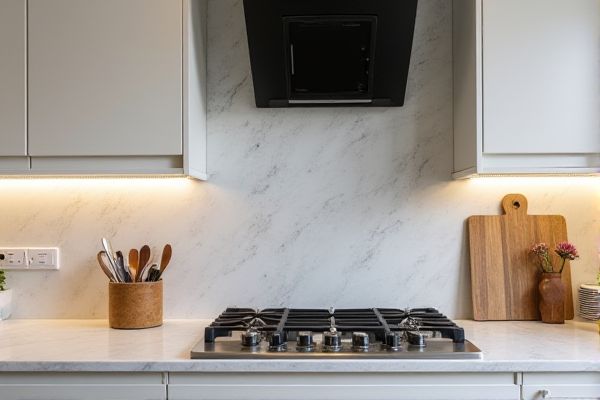
Tile splashbacks offer versatility with numerous design options, while slab splashbacks provide a sleek, seamless look that is easy to clean and maintain. Explore the rest of this article to discover which option best suits Your kitchen style and functionality needs.
Table of Comparison
| Feature | Tile Splashback | Slab Splashback |
|---|---|---|
| Material | Ceramic, porcelain, glass, or natural stone tiles | Single large piece of granite, marble, quartz, or engineered stone |
| Appearance | Patterned, mosaic, textured design options | Smooth, seamless, modern look |
| Installation | Requires grout lines; more labor-intensive | Quick, less grout or joints |
| Maintenance | Grout can stain; requires regular cleaning and sealing | Easy to clean; minimal sealing needed |
| Durability | Moderate; tiles may chip or crack | High; strong and resistant to damage |
| Cost | Generally lower cost; affordable options available | Higher cost; premium material price |
| Customization | Wide variety of colors, shapes, and sizes | Limited to slab dimensions and finishes |
| Typical Use | Traditional and decorative kitchens | Modern, sleek, and minimalist kitchens |
Introduction to Kitchen Splashbacks
Kitchen splashbacks serve as protective and decorative surfaces between countertops and cabinets, preventing water damage and stains. Tile splashbacks offer versatile design options with grout lines that add texture but may require regular maintenance to prevent mold. Slab splashbacks, typically made from materials like quartz or granite, provide a seamless, durable surface that is easier to clean and gives a modern aesthetic.
What Is a Tile Splashback?
A tile splashback consists of individual ceramic, glass, or porcelain tiles arranged to protect your kitchen walls from cooking splashes and stains. Tiles offer versatile design options with various colors, patterns, and textures that can be customized to match your style. Compared to slab splashbacks, tile splashbacks allow for easier replacement of damaged sections and typically provide more intricate visual detail.
What Is a Slab Splashback?
A slab splashback is a single, continuous piece of material such as granite, quartz, or marble, installed vertically on the wall behind kitchen countertops to protect against spills and splashes. Unlike tile splashbacks, which consist of multiple small pieces joined by grout lines, slab splashbacks offer a seamless, sleek appearance and are easier to clean and maintain. The absence of grout reduces the risk of mold and staining, making slab splashbacks a popular choice for modern kitchen designs focused on durability and aesthetics.
Aesthetic Differences: Tile vs Slab
Tile splashbacks offer a versatile range of patterns, colors, and textures, allowing for intricate designs and personalized aesthetics in your kitchen or bathroom. Slab splashbacks provide a sleek, seamless appearance with minimal grout lines, creating a modern and clean look that emphasizes simplicity and elegance. Choosing between tile and slab impacts the overall style of your space, with tiles lending a classic or decorative vibe, while slabs deliver a contemporary and minimalist aesthetic.
Cost Comparison: Tile Splashback vs Slab Splashback
Tile splashbacks generally offer a more budget-friendly option, with costs ranging from $20 to $50 per square foot, depending on the material and design complexity. Slab splashbacks, typically made from materials like granite, quartz, or marble, command higher prices, often between $50 to $150 per square foot due to material quality and installation requirements. Labor costs for tile installation may be higher because of grouting and pattern alignment, whereas slabs require precise cutting and fitting but usually involve quicker installation times.
Durability and Maintenance
Tile splashbacks offer high durability due to their resistance to heat and moisture, while individual grout lines require regular cleaning to prevent mold and staining. Slab splashbacks, often made from materials like quartz or granite, provide seamless surfaces that are easier to maintain and less prone to damage over time. Both options offer long-lasting protection, but slabs typically require less upkeep and deliver a more hygienic kitchen environment.
Installation Process and Complexity
Tile splashbacks require meticulous grout application and precise alignment of multiple tiles, making the installation process more labor-intensive and time-consuming. Slab splashbacks, typically made from quartz, marble, or granite, offer a seamless installation with fewer joints, reducing complexity and maintenance needs. Your choice impacts the ease of installation and the final aesthetic, with slabs providing a streamlined, modern look compared to the detailed, customizable patterns possible with tiles.
Pros and Cons of Tile Splashbacks
Tile splashbacks offer a versatile and affordable option with a wide range of colors, patterns, and styles, making them ideal for personalized kitchen designs. They are easy to install, repair, and replace, providing flexibility and practicality in your space. However, grout lines can accumulate dirt and require regular cleaning, and some tiles may be more prone to chipping or cracking compared to slab splashbacks.
Pros and Cons of Slab Splashbacks
Slab splashbacks offer a sleek, modern aesthetic with fewer grout lines, making them easier to clean and more resistant to mold and stains compared to traditional tile splashbacks. They are typically made from materials like quartz, granite, or marble, which provide superior durability and heat resistance but can be more expensive and harder to replace if damaged. Installation requires precise cutting and professional fitting, limiting DIY options and potentially increasing upfront costs.
Which Splashback Is Right for Your Kitchen?
Tile splashbacks offer versatility with various designs, colors, and textures, making them ideal for those seeking customization and easier repairs. Slab splashbacks, typically made from granite, quartz, or marble, provide a seamless, modern look and superior durability against stains and heat. Your choice depends on whether you prioritize design flexibility or a sleek, low-maintenance surface for your kitchen.
 homyna.com
homyna.com